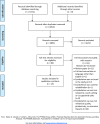Quality, productivity, and economic implications of exoskeletons for occupational use: A systematic review
- PMID: 37368889
- PMCID: PMC10298758
- DOI: 10.1371/journal.pone.0287742
Quality, productivity, and economic implications of exoskeletons for occupational use: A systematic review
Abstract
The objective of this systematic review was to synthesize the current state of knowledge on the quality and productivity of workers and their work while wearing exoskeletons, as well as the economic implications of exoskeletons for occupational use. Following the PRISMA guidelines, six databases were systematically searched for relevant journal articles, written in English, and published since January 2000. Articles meeting the inclusion criteria had their quality assessed using JBI's Checklist for Quasi-Experimental Studies (Non-Randomized Experimental Studies). A total of 6,722 articles were identified and 15 articles focusing on the impact of exoskeletons on quality and productivity of exoskeleton users while performing occupational tasks were included in this study. None of the included articles evaluated the economic implications of exoskeletons for occupational use. This study revealed several quality and productivity measures (e.g., endurance time, task completion time, number of errors, number of task cycles completed) used to evaluate the impact of exoskeletons. The current state of the literature suggests that quality and productivity impacts of exoskeleton use are dependent on task characteristics that should be considered when adopting exoskeletons. Future studies should evaluate the impact of exoskeleton use in the field and on a diverse pool of workers, as well as its economic implications to better support decision-making in the adoption of exoskeletons within organizations.
Copyright: © 2023 Fournier et al. This is an open access article distributed under the terms of the Creative Commons Attribution License, which permits unrestricted use, distribution, and reproduction in any medium, provided the original author and source are credited.
Conflict of interest statement
The authors have declared that no competing interests exist.
Figures
Similar articles
-
Manufacturing Industry Stakeholder Perspectives on Occupational Exoskeletons: Changes after a Brief Exposure to Exoskeletons.IISE Trans Occup Ergon Hum Factors. 2023 Jul-Oct;11(3-4):71-80. doi: 10.1080/24725838.2023.2262480. Epub 2023 Oct 6. IISE Trans Occup Ergon Hum Factors. 2023. PMID: 37747446
-
The Effects of Upper-Body Exoskeletons on Human Metabolic Cost and Thermal Response during Work Tasks-A Systematic Review.Int J Environ Res Public Health. 2020 Oct 9;17(20):7374. doi: 10.3390/ijerph17207374. Int J Environ Res Public Health. 2020. PMID: 33050273 Free PMC article.
-
Heuristic Evaluations of Back-Support, Shoulder-Support, Handgrip-Strength Support, and Sit-Stand-Support Exoskeletons Using Universal Design Principles.IISE Trans Occup Ergon Hum Factors. 2025 Jan-Mar;13(1):18-31. doi: 10.1080/24725838.2025.2476438. Epub 2025 Mar 14. IISE Trans Occup Ergon Hum Factors. 2025. PMID: 40083264
-
A framework for evaluation and adoption of industrial exoskeletons.Appl Ergon. 2023 Nov;113:104103. doi: 10.1016/j.apergo.2023.104103. Epub 2023 Jul 25. Appl Ergon. 2023. PMID: 37499526
-
Industrial exoskeletons from bench to field: Human-machine interface and user experience in occupational settings and tasks.Front Public Health. 2022 Nov 21;10:1039680. doi: 10.3389/fpubh.2022.1039680. eCollection 2022. Front Public Health. 2022. PMID: 36478728 Free PMC article.
Cited by
-
Integrating collaborative robots in manufacturing, logistics, and agriculture: Expert perspectives on technical, safety, and human factors.Front Robot AI. 2024 Dec 2;11:1342130. doi: 10.3389/frobt.2024.1342130. eCollection 2024. Front Robot AI. 2024. PMID: 39687349 Free PMC article.
-
Research and Design of a Medial-Support Exoskeleton Chair.Biomimetics (Basel). 2025 May 18;10(5):330. doi: 10.3390/biomimetics10050330. Biomimetics (Basel). 2025. PMID: 40422160 Free PMC article.
References
-
- Lajeunesse V, Vincent C, Routhier F, Careau E, Michaud F. Exoskeletons’ design and usefulness evidence according to a systematic review of lower limb exoskeletons used for functional mobility by people with spinal cord injury. Disabil Rehabil Assist Technol 2016;11:535–47. doi: 10.3109/17483107.2015.1080766 - DOI - PubMed
Publication types
MeSH terms
LinkOut - more resources
Full Text Sources


